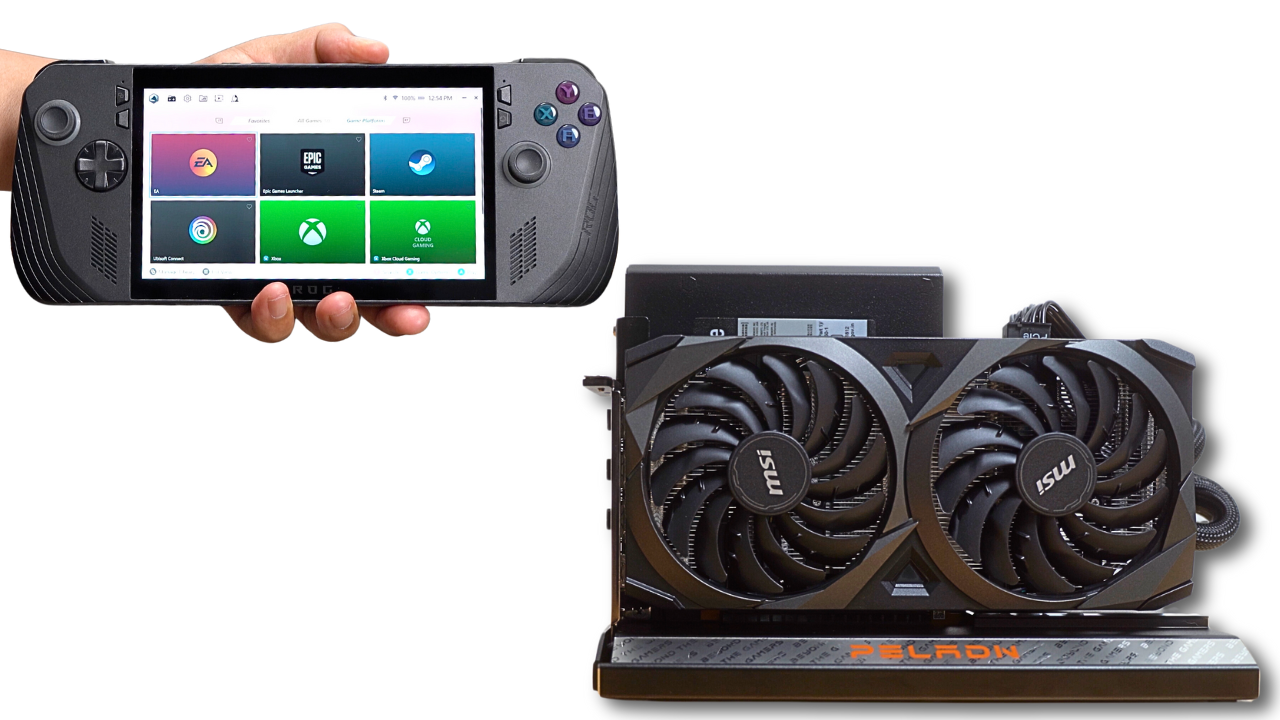I connected my ROG Ally X to an RTX 3060 graphics card, and the results were nothing short of fascinating. I’ll walk you through the setup process, the challenges I faced, and the massive performance gains I achieved. Watch my video about this install herehttps://youtu.be/e2gletk27dE
The journey began with my decision to pick up an RTX 3060. I’m no computer expert, but the specs caught my eye—12 GB of GDDR6 memory, a 192-bit memory bus, and a memory speed of 15 GB/s with 3,584 CUDA cores. It also supports a max resolution of 7680 x 4320, which felt like future-proofing my setup. But let’s be honest, what really sealed the deal was the price: $284 on Amazon, coupled with over 3,000 purchases last month.
To power the GPU, I bought the Corsair RM 750e fully modular ATX power supply. It’s quiet, thanks to a 120mm rifle-bearing fan, and its fully modular design meant I didn’t have to deal with extra cables cluttering the setup. Connecting the Ally X to the graphics card required a Peladn Link S1 dock, which uses Thunderbolt 3 to offer transmission speeds of 40 Gbps while also supplying 60W charging. I was impressed by the dock’s features, including a slot for an M.2 NVMe SSD, but I ran into a small issue with its build quality. One corner looked like it was coming apart, though it didn’t impact performance.
Setting Up the Beast
Putting everything together was a mix of straightforward steps and minor hiccups. First, I mounted the power supply to the dock using screws, then attached a bracket to secure the GPU. Once the graphics card was in place, I installed my Samsung 2TB SSD—though I lost the screw during the process. Thankfully, my collection of old computer screws saved the day.
With the hardware in place, I connected the PCIe cable from the power supply to the GPU and another cable from the power supply to the dock. Turning on the power supply and seeing the GPU fans spin up was a reassuring moment that everything was connected correctly.
Next came the software. I downloaded NVIDIA’s game-ready driver for the RTX 3060 and installed it on my Ally X. Using my HP Omen monitor (27-inch, 240 Hz, 2560 x 1440 resolution), I completed the installation process and disabled the AMD graphics drivers to focus solely on the RTX 3060.
Testing the Ally X Without the GPU
Before diving into the RTX 3060’s performance, I wanted to establish a baseline for the Ally X’s internal GPU. Running games at 1080p and 60 Hz, I saw Cyberpunk 2077 average 23.9 FPS on default settings. GTA 5 fared a little better at 30 FPS, while Forza Horizon impressed me with an average of 58 FPS on medium settings. Mortal Kombat 1 and Black Myth Wukong were playable, but their frame rates hovered around 30 and 75 FPS, respectively. These results made it clear that the Ally X’s internal graphics are capable but limited for more demanding games.
Plugging in the RTX 3060
With the RTX 3060 connected, the transformation was immediate. Cyberpunk 2077 jumped to 57 FPS at 1080p, delivering noticeably smoother gameplay and improved visuals. At 1440p, it still managed 45.9 FPS, which felt like a huge improvement over the internal GPU. Similarly, GTA 5 hit 60 FPS at 1080p and 74.6 FPS at 1440p, with Forza Horizon climbing to 64 FPS at the higher resolution. Mortal Kombat 1 and Black Myth Wukong also showed significant gains, with Wukong reaching a staggering 134 FPS at 1080p on low settings.
Exploring NVIDIA’s Tools
The NVIDIA app was another highlight of this setup. It offered a range of features, from automatic game optimization to detailed performance stats. I was especially impressed by the in-game performance overlay, which let me monitor FPS and system performance in real time. While some advanced features like manual tuning felt a bit over my head, the app’s user-friendly interface made it a valuable addition to my setup.
Benchmarking the Ally X vs. the RTX 3060
To get a clearer picture of the performance gains, I ran benchmarks using 3DMark Time Spy, Fire Strike, Unigine Heaven, and MSI’s Benchmark. The Ally X’s internal GPU performed decently at 1080p, but adding the RTX 3060 was like flipping a performance switch. Scores and frame rates soared at 1080p, and even at 1440p, the RTX 3060 held its own with only minor dips. These benchmarks confirmed what I’d already felt in gameplay: the external GPU was a game-changer.
Final Thoughts
So, should you connect your ROG Ally X to an external GPU? For most people, the Ally X’s internal graphics are more than sufficient for casual desktop gaming, especially with tools like AMD’s AMMF to boost performance. However, if you’re looking to push your gaming experience to the next level with higher resolutions and better graphics settings, an external GPU like the RTX 3060 is a fantastic upgrade.
Personally, I loved the performance boost and the thrill of turning my Ally X into a desktop gaming powerhouse. Plus, the flexibility to upgrade to an even better GPU down the road is a big bonus.
